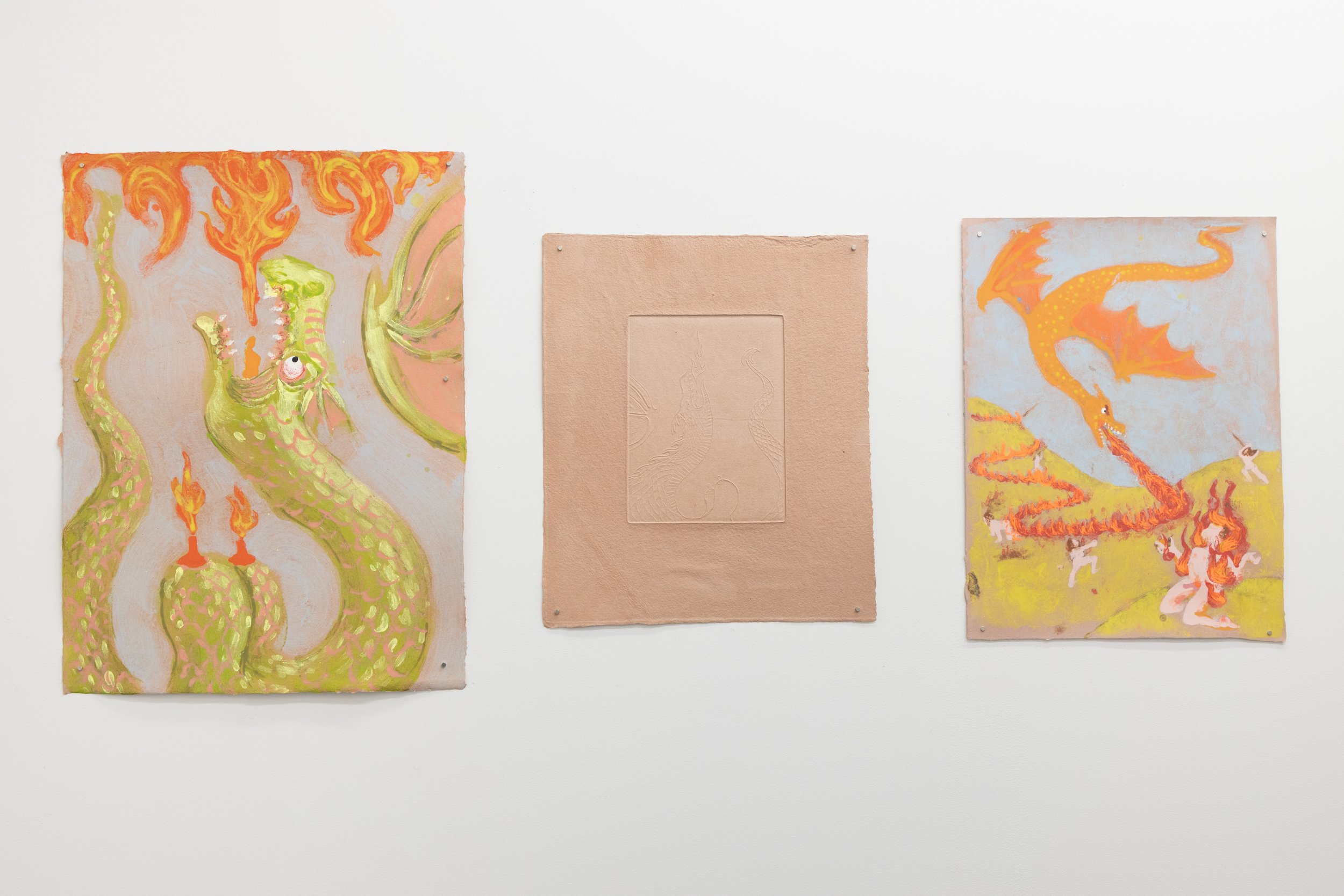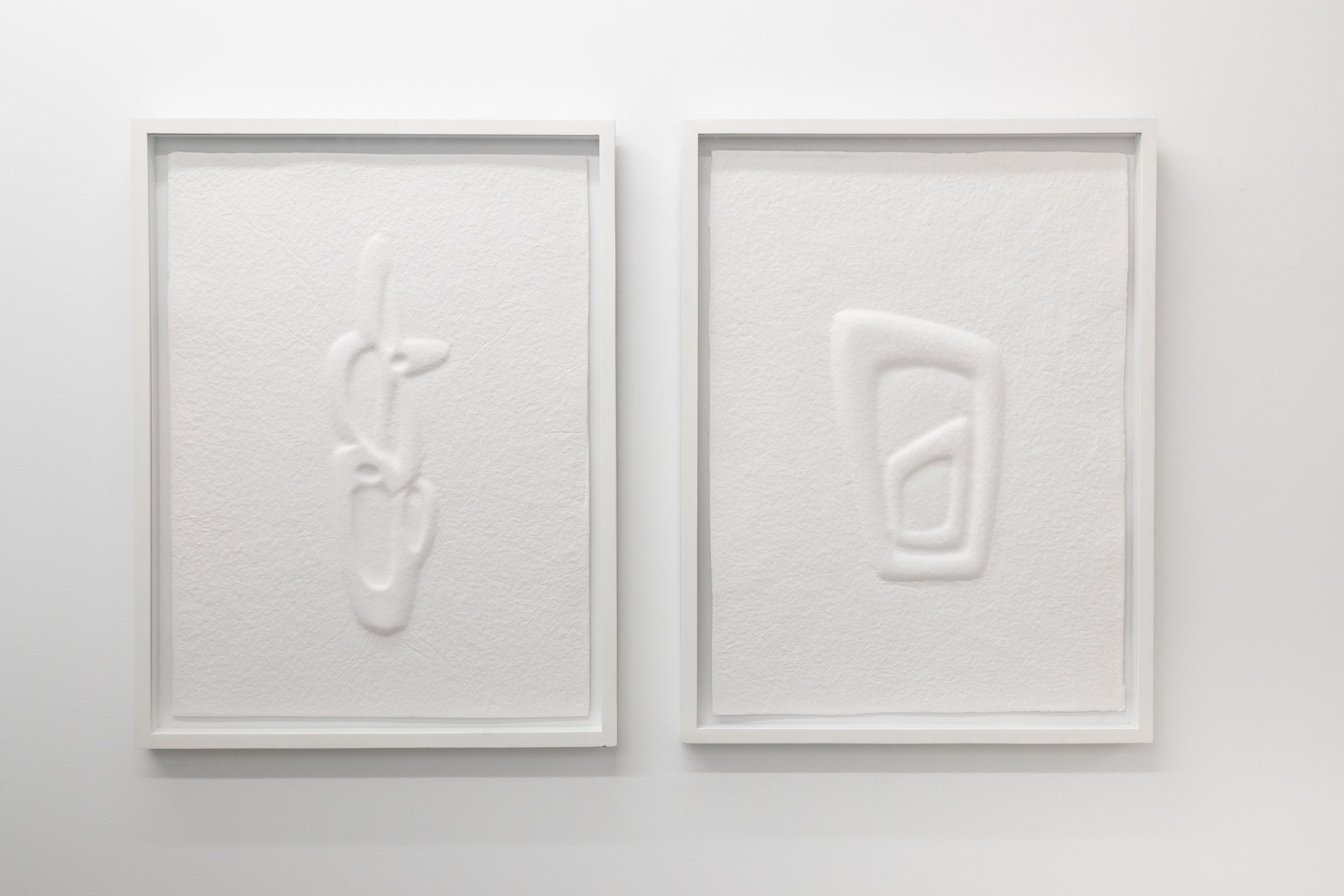
Power Play
Patrica Ayres, David Baskin, Aisha Tanidwe Bell, and Anastasiya Tarasenko
Curated by Eliana Blechman





























Dieu Donné is pleased to present Power Play, an exhibition featuring works in handmade paper by Dieu Donné’s 2022 Workspace Residents: Patricia Ayres, David Baskin, Aisha Tandiwe Bell, and Anastasiya Tarasenko. Over the course of their residencies, each artist explored the possibilities of hand papermaking to identify and upend traditional gender, racial, or economic structures of power, control, and influence. Using pulp painting, casting, mold making, embedding, and blowouts, among other techniques, the included artists found diverse ways to utilize the transformative power of paper in constructing new critical frameworks.
Patricia Ayres examines corporeal forms, corporal punishment, and religious structures in her practice. She points to Catholicism and incarceration as dual modes of restriction in contemporary society, which each control the minds and/or bodies of the masses. Ayres draws on her training in fashion throughout her work, often incorporating textiles into her sculptures and creating allusions to encased bodies through bounded figurative forms with protruding bumps. At Dieu Donné, Ayres created a series of works exploring the structures and iconographies ofCatholicism. The artist repurposed iconic religious items, reconfiguring them into abstract shapes and textures. Ayres created blowouts of stark black paper pulp shaped as religious figures’ uniforms, including nuns’ habits and veils, and recreated the floor plan of the apse in the Chapel of St. Peter’s Basilica. By simplifying her source images into single-color shapes, Ayres removes the viewer’s ability to immediately identify each form, abstracting the objects’ or architecture’s original power and sway. In another body of work made at Dieu Donné, Ayres embedded and debossed materials pulled from religious function, including holy communion wafers, ashes, and a repeating sequence of the Roman Collars worn by priests, into thick columns of black or white cotton pulp. The embedded wafers and ash create noticeable stains in the surface of Ayres’ material, permeating the pulp in splotches and smears across the otherwise pristine surface of paper. In reinterpreting the worn markers of religious control, Ayres removes the objects’ ceremonial power, breaking down modes of religious authority into abstracted forms.
David Baskin draws from the language and aesthetics of consumerism in his practice, humorously questioning authorship, concepts of value and brand recognition, and the delineations between the art-versus mass-market. Appropriating, manipulating, and reconfiguring mass-produced items into new forms, Baskin displaces the original functionality of his sources to render them as purely aesthetic objects. In his most recent series of work, Baskin repurposed decorative objects from big box stores like Home Depot, West Elm, and IKEA. Casting the mass-marketed designs to recreate them in new mediums, textures, and colors, Baskin created new artworks which ironically still maintain the use-function of their sources but offer more precious and unique iterations of their intended experience. Working with paper pulp at Dieu Donné, Baskin further experimented with the transformation of production and material as transformation of value of the object, employing a time-consuming process of packing rubber molds with richly pigment cotton pulp. In re-casting and re-forming purchased decorative objects, Baskin elevates the material, transforming mass-market, machine-made design into hand-made, conceptually rigorous fine art.
Aisha Tandiwe Bell's work explores the tension between the flat and the sculptural within the context of race and culture. Often working in installation, Bell paints two-dimensional bodies on canvas, on wooden board, or directly on gallery walls, and then layers protruding ceramic heads and textile elements on top. The static bodies of Bell’s figures allude to the flattening of identity through racial, gender, and class stereotypes, while her sculpted heads act as archetypes rather than specific portraits. Through these installations, Bell brings her figures to life––inviting them to spring off the gallery walls. She subverts the literal flattening of character to create layered, meaningful cultural commentaries. At Dieu Donné, Bell translated her painting and ceramic practices into hand papermaking, casting and wrapping multi-colored, patterned, and textured faces, and building layers of pulp-painted paperworks.The artist created component parts in the wet studio, constructing them once dry to build repetitions in pattern that simultaneously obscure and loudly announce their presence. In creating this series of cast paper heads, Bell explores and reveals the multiple versions of self that she is forced to take on when navigating hostile environments, family, people, and stereotypes of race, sex, and class.
In Anastasiya Tarasenko’s colorful, detailed, and intricatework, the artist plays with figures and forms inspired by folk tales, fantasy, and history to comment on gender roles, politics, and contemporary culture. Through the rich buildup of material and meticulously rendered imagery, Tarasenko creates moments where joy, humor, violence, and tragedy intersect in unexpected ways. She transforms whimsical figures into sexualized, violent, or irreverent characters, upending traditional and often familiar references for complex, modernized contexts.In her painting practice, Tarasenko builds up panels with thick swathes of textured oil paint to create abundantly detailed environments. While in residence at Dieu Donné, the artist focused on individual or small groups of invented characters, largely using linen pulp paint to create layered scenes of fantastical figures. Tarasenko’s detailed buildup of vibrant color and painterly application of the linen pulp belies the smoothness of the two-dimensional surface of handmade cotton, hemp, and abaca paper. A series of debossed paper works made at Dieu Donné depicting individual forms, including a Rapunzel-like woman spraying milk from exposed breasts, a large-breasted, fire-breathing dragon, and a hanged swan reformat the dimensionality of Tarasenko’s paintings into muted palettes that are reminiscent of leatherbound fairytale book covers.
Photos by Haley Sessoms.

























